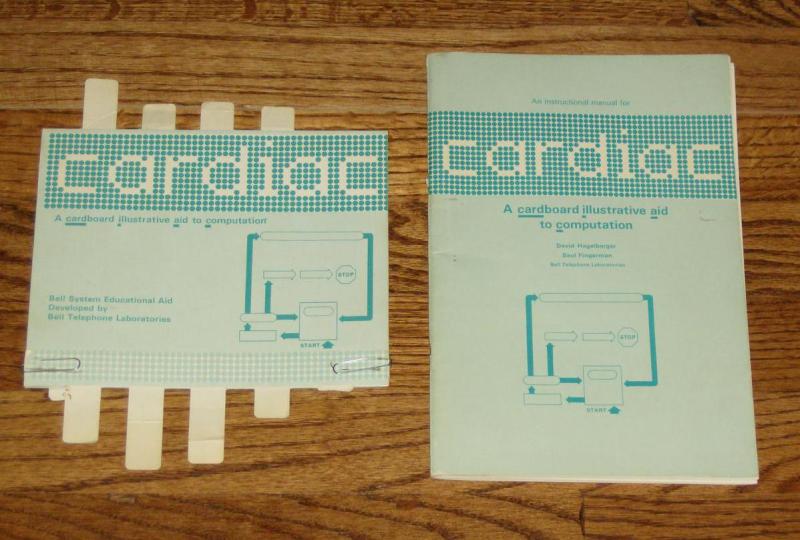Back in the 70’s when computers were fairly expensive and out of reach for most people, [David Hagelbarger] of Bell Laboratories designed CARDIAC: CARDboard Illustrative Aid to Computation. CARDIAC was designed as an educational tool to give people without access to computers the ability to learn how computers work.
The CARDIAC computer is a single-accumulator single-address machine, which means that instructions operate on the accumulator alone, or on the accumulator and a memory location. The machine implements 10 instructions, each of which is assigned a 3-digit decimal opcode. The instruction set architecture includes instructions common to simple Von Neumann processors, such as load, store, add/subtract, and conditional branch.
Operating the computer is fairly simple–the cardboard slides guide you through the operation of the ALU and instruction decoder, and the flow chart shows you which stage to go to next. The program counter is represented by a cardboard ladybug which is manually moved through the program memory after each instruction completes.
Even though the CARDIAC is dated and very simplistic, it is still a useful tool to teach how microprocessors work. Although modern processors include multi-stage pipelines, finely-tuned branch predictors, and numerous other improvements, the basic principles of operation remain the same.
Feeling adventurous? Print out your own CARDIAC clone and try writing your first cardboard computer program.
[via Reddit]
















How long till someone here writes an emulator. Or is it too late already?
The little man computer is very similar to cardiac in which they are both 3 decimal digit coded.
Here is a simulator for LMC learning.
https://www.youtube.com/watch?v=HNK9imVcz_E
It is part of a project for an assembler learning machine.
http://www.simpleavr.com/msp430-projects/ez430trainer
http://boingboing.net/2009/06/03/cardiac-paper-comput-1.html
Click post too quickly. Previous link goes pretty much nowhere. This is an excel spread sheet that will emulate it. http://www.drdobbs.com/embedded-systems/cpu-design-on-paper/240153480
There’s also an online simulator: https://www.cs.drexel.edu/~bls96/museum/cardsim.html
The article you link to says it has been around since 1969. That makes a lot more sense than “the 80s”, as I used CARDIAC in high school back in 1980, and it was a bit antiquated even then.
Good catch! Looks like it’s been around a lot longer than I thought.
Yep. 1972 here and it’d been in use for a while. Then it was on to punched cards and other mayhem…
I remember tinkering with this back about 1972 (5th grade?) I didn’t go much further with it than learning how it operated, and maybe adding a couple numbers – but it did a very good job laying out how computers worked.
Starts porting Linux….
I still have one of theses from way back in the day:
http://www.retrothing.com/2009/10/build_your_own_.html
I think I bought it from an Edmund Scientific catalog.
Mechanical computers are cool.
Mom had one of those when she was young! (She and I have talked about it quite a bit.) Fun times, I’m told… she tells me that in high school she did the whole flowcharts-and-punch-cards routine (this would have been the early 70s). In college, a few years later, she created and ran the first computerized card catalog for the library’s periodicals section.
Hey, does anyone at Bergen Co. Community College in NJ know what minicomputer they had back in the mid- to late 1970s? Inquiring minds want to know! …well, OK, /an/ inquiring mind. I’m probably the only one on Earth who’d care. LOL. (Mom has no idea. All she remembers is that the floor was made of ceiling tile like material and there were a half-dozen air conditioners making it cold enough almost to snow in the room! Not to mention, those old minis all look about the same to her…)
*ahem*
I think I’m going to put together a CARDIAC myself — looks intriguing. Should be fun to try it out…
Probably wasn’t a minicomputer if she was in a coldroom, it was probably the IBM 370 mainframe. The minis, unless there were several, didn’t require the same kind of coldroom setup. The floor was indeed panels that were raised (you had to enter via a ramp or steps) so you had access to the wiring between the components like the card reader, or the tape drives, and it allowed the refrigerated air to flow under and cool the bottom of the computer as well. By the time I was using one, we still had to boot the computer using cards, but we had actual 5 megabyte hard drives! The disks were about the size of a LP record and each disk was 1 megabyte of storage. They were arrayed in a stack of 5 disks in a large plastic tower-thing that you twisted and pulled to remove. Pretty cool.
I used this in high school comp Sci before we got a lab of apple //e. Previously, it was timeshare to the local university.
And the wikipedia page: http://en.wikipedia.org/wiki/CARDboard_Illustrative_Aid_to_Computation
I encountered this in the CS program at UC Berkeley in the 1980s. Ah, memories!
Fascinating. I suppose it can compute, so it is a computer.
dumpster rental sizes
link http://www.ali-gipp.com/sitemap715.php